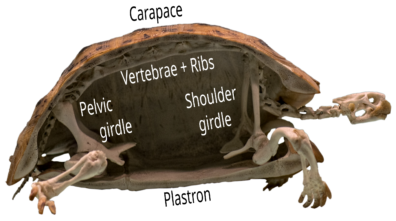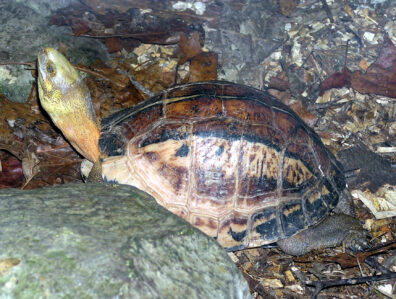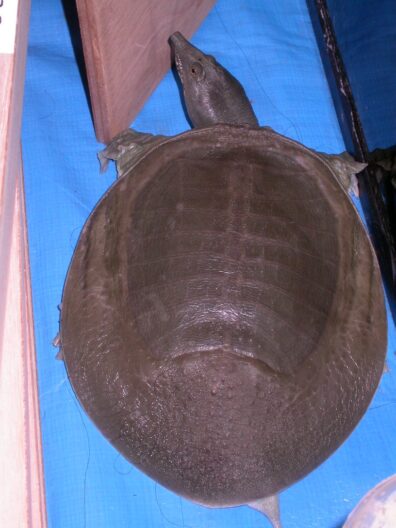Dear Malachi,
Sometimes animated turtles seem to live inside their shells like it’s a tiny home. They may even hop out of the shell and run around.
That’s funny in cartoons and games, but my friend Ryan Wagner told me it could never happen in real life. He’s a wildlife biologist at Washington State University. He studies animals like turtles and frogs.
It turns out that a turtle’s shell doesn’t sit on top of its body. It’s part of the turtle’s body.
“Turtles are their shells,” Wagner said. “The shell is made up of their bones. As the turtle grows, its shell grows along with it—just like our bones do.”
Also like our bones, a turtle’s shell forms when the turtle is an embryo. That’s when it’s still inside the egg. The shell starts out soft and hardens as the baby turtle grows.

This is what a turtle looks like inside its egg as its shell and other parts develop. If you think it looks a little bit like a chick embryo, you’re not wrong! Turtles are more closely related to birds than they are to lizards and snakes. Image: Akashi et al. Sci Rep 12, 11619 (2022).
The bones of a turtle’s shell are similar to the ones we have. The shell is the turtle’s backbone and rib cage with the collarbone, shoulder bones and pelvic bones tucked inside. A turtle’s rib bones are wide and flat. They’re fused together to form a solid shell.

This is what a turtle’s skeleton looks like. Scientists think ancient turtle ancestors evolved the belly part (plastron) before the back part (carapace). That adaptation maybe helped them live underground or underwater. Ian Alexander CC BY-SA 4.0
The shell has two parts. The helmet-like dome that covers the back is the carapace. The bony plate that covers the belly is the plastron.
The carapace and plastron are connected along the turtle’s sides. Its head and front legs stick out the front. Its tail and back legs stick out the rear. All the turtle’s mushy organs are sandwiched between the carapace and plastron.
The bones of the shell have a protective covering. In many turtles, it’s made of keratin plates called scutes. Keratin is the same protein that’s in our hair and toenails. Some turtles have a leathery covering instead.


Lots of turtles—like this box turtle (left)—have hard scutes covering its shell. Soft-shelled turtles (right) have leathery skin covering their shells. Adrian Pingstone, Clunio CC BY-SA 3.0
Some turtles can pull their head and legs into their shells. They have a hinged plastron that flexes up and down. They use their muscles to pull their whole body inside. Then they squeeze the carapace and plastron together to make a tight seal.
That’s super handy for protecting turtles from predators. But it can be tough for scientists who study them.
“In college, I had a job clipping box turtles’ toenails,” Wagner said. “We used the toenail samples to determine how stressed the turtles were. But they would pull their legs and head inside and clamp up—and there’s basically no grip that you can get with your hands to try to pull the shell open.”
A turtle’s shell is sensitive. It houses the spinal cord and lots of nerves. So, turtles can feel anything that touches their shell.
Wagner told me that turtles are quite vulnerable to shell injuries and other threats, like habitat loss or overharvesting.
“Turtles are in trouble,” he said. “There are about 350 species of turtles, found on every continent except Antarctica. About half of them are at risk of extinction. Some consider them to be the most endangered group of vertebrates in the world. They need our help.”
The best way to help is to admire wild turtles from a distance and protect their homes. And never release a pet turtle into the wild.
Together we can protect these spe-shell animals.
Sincerely,
Dr. Universe